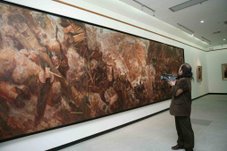 Look what just popped up on the Internet: a one hour on-line video of a live webcast with Zhiwei Tu, produced by Tom.com this past June.
Look what just popped up on the Internet: a one hour on-line video of a live webcast with Zhiwei Tu, produced by Tom.com this past June. One hour!!
The event was held in connection with Mr. Tu's one-man show at the National Art Museum of China. Tom.com is a "mobile internet company" specializing in web-casting (as opposed to more traditional "broadcasting") to a wide audience throughout China.
The program, naturally, is in Chinese. Just as happens with regular TV, a studio host interviewed Mr. Tu about the NAMOC show, his early years in a remote farming village when he was discovered to be a prodigy at painting, and his move to the U.S.A. to further his art education. What's so different with this "webcast" is that there was ample time to explore additional subjects and take live questions from viewers, apparently sent in by email or text-messaging.
Among the many subjects covered are the differences between art education in China and the U.S., the practicalities of how newly arrived Chinese artists can get by in the West, the inspiration Mr. Tu drew from his artistic mentor in the U.S., etc. etc. Several viewers apparently wanted to know more about the Oil Painters of America, a relatively new but very effective organization of artists (with affiliates in Canada and Mexico) that has helped to introduce the art work of many domestic and newly-arrived foreign artists to a Western audience.
Shorter excerpts of the interview can be viewed on the Tu Zhiwei Art Gallery web site here. For non-Chinese speakers, English summaries are provided.
Of the excerpts available, our favorite is "The Artistic Passion of Tu Zhiwei: Ten Epic Murals in Ten Years." It runs a little over six minutes. In this segment, Mr. Tu discloses that the five giant murals he's completed are just half of the ten he plans to do before "I rest in peace." One of them, he explains, is about Confucious.
Take a look at the first five murals and you can see why so many people are excited at what is yet to come from this extraordinary artistic genius.







